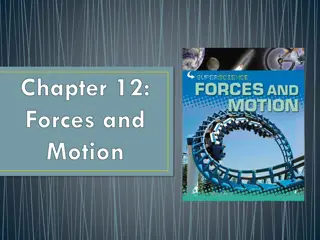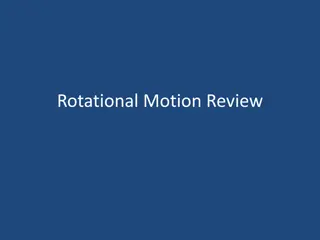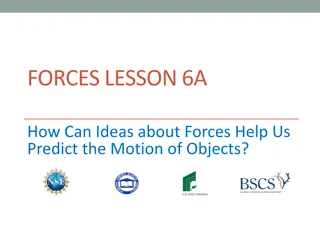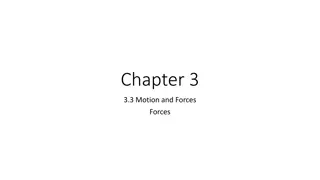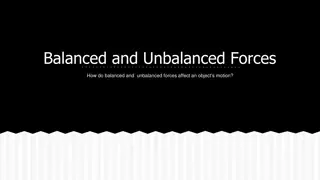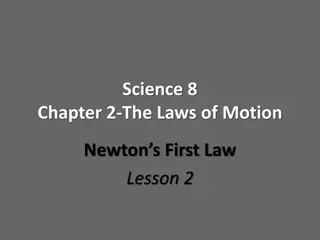Understanding Forces in Motion Throughout History
Forces play a crucial role in causing changes in motion, as observed through the perspectives of Aristotle on natural and violent motion, the beliefs about Earth's rest, and Copernicus challenging the geocentric view with a heliocentric model. The concept of forces driving motion has evolved over centuries, shaping our understanding of the physical world.
Download Presentation

Please find below an Image/Link to download the presentation.
The content on the website is provided AS IS for your information and personal use only. It may not be sold, licensed, or shared on other websites without obtaining consent from the author. Download presentation by click this link. If you encounter any issues during the download, it is possible that the publisher has removed the file from their server.
E N D
Presentation Transcript
Forces cause changes in motion.
A ball at rest in the middle of a flat field is in equilibrium. No net force acts on it. If you saw it begin to move across the ground, you d look for forces that don t balance to zero. We don t believe that changes in motion occur without cause.
3.1 Aristotle on Motion Aristotle, studied motion and divided it into two types: natural motion violent motion.
Natural motion on Earth was thought to be either straight up or straight down. Objects seek their natural resting places: boulders on the ground and smoke high in the air like the clouds. Heavy things fall and very light things rise. These motions were considered natural not caused by forces.
Violent motion, on the other hand, was imposed motion. It was the result of forces that pushed or pulled. The important thing about defining violent motion was that it had an external cause. Objects in their natural resting places could not move by themselves.
Boulders do not move without cause.
It was commonly thought for nearly 2000 years that a force was responsible for an object moving against its nature. The state of objects was one of rest unless they were being pushed or pulled or moving toward their natural resting place. Most thinkers before the 1500s considered it obvious that Earth must be in its natural resting place. A force large enough to move it was unthinkable. Earth did not move.
3.2 Copernicus and the Moving Earth Copernicus reasoned that the simplest way to interpret astronomical observations was to assume that Earth and the other planets move around the sun.
The astronomer Nicolaus Copernicus (1473 1543) formulated a theory of the moving Earth. Idea was extremely controversial, People preferred to believe that Earth was at the center of the universe. Copernicus worked on his ideas in secret.
Nicolaus Copernicus proposed that Earth moved around the sun.
3.3 Galileo on Motion Galileo argued that only when friction is present as it usually is is a force needed to keep an object moving.
3.3 Galileo on Motion Galileo, was outspoken in his support of Copernicus. One of Galileo s great contributions to physics was demolishing the notion that a force is necessary to keep an object moving.
3.3 Galileo on Motion Friction is the name given to the force that acts between materials that touch as they move past each other. Friction is caused by the irregularities in the surfaces of objects that are touching. If friction were absent, a moving object would need no force whatever to remain in motion.
Galileo tested his idea by rolling balls along plane surfaces tilted at different angles. A ball rolling down an inclined plane speeds up. A ball rolling up an inclined plane in a direction opposed by gravity slows down. A ball rolling on a smooth horizontal plane has almost constant velocity.
a. Downward, the ball moves with Earth s gravity.
a. Downward, the ball moves with Earths gravity. b. Upward, the ball moves against gravity.
a. Downward, the ball moves with Earths gravity. b. Upward, the ball moves against gravity. c. On a level plane, it does not move with or against gravity.
Galileo stated that if friction were entirely absent, a ball moving horizontally would move forever. No push or pull would be required to keep it moving once it is set in motion.
Galileos conclusion was supported by another line of reasoning. He described two inclined planes facing each other. A ball released to roll down one plane would roll up the other to reach nearly the same height. The ball tended to attain the same height, even when the second plane was longer and inclined at a smaller angle than the first plane.
a. The ball rolling down the incline rolls up the opposite incline and reaches its initial height.
a. The ball rolling down the incline rolls up the opposite incline and reaches its initial height. b. The ball rolls a greater distance to reach its initial height.
a. The ball rolling down the incline rolls up the opposite incline and reaches its initial height. b. The ball rolls a greater distance to reach its initial height. c. If there is no friction, the ball will never stop.
If the angle of incline of the second plane were reduced to zero so that the plane was perfectly horizontal, only friction would keep it from rolling forever. It was not the nature of the ball to come to rest as Aristotle had claimed.
Galileo stated that this tendency of a moving body to keep moving is natural and that every material object resists changes to its state of motion.
The property of a body to resist changes to its state of motion is called inertia.
think! A ball is rolled across a counter top and rolls slowly to a stop. How would Aristotle interpret this behavior? How would Galileo interpret it? How would you interpret it?
Answer: Aristotle would probably say that the ball stops because it seeks its natural state of rest. Galileo would probably say that the friction between the ball and the table overcomes the ball s natural tendency to continue rolling overcomes the ball s inertia and brings it to a stop. Only you can answer the last question!


